A Novel Monopole Ultra-Wide-Band Multiple-Input Multiple-Output Antenna with Triple-Notched Characteristics for Enhanced Wireless Communication and Portable Systems
Abstract
1. Introduction
2. Proposed Antenna Design
- The UWB design achieves a bandwidth of 2 GHz to 13 GHz by feeding a rectangular patch with a ground plane.
- Notching characteristics are introduced in the UWB frequency range by placing a CSRR at the feeding point of the patch and another CSRR in the ground plane. Additionally, a curve shape is employed to create a notch for the satellite network band. The CSRR in the feeding line rejects the C-band, while the CSRR in the ground plane rejects the WLAN bands. Both CSRR elements increase the coupling effects and filter high-traffic bands.
- The 4 × 4 MIMO configuration is achieved by arranging the monopole antennas in an orthogonal configuration, providing pattern diversity and polarization diversity.
- High isolation within the MIMO system is achieved by utilizing the mutual coupling of CSRR elements at the patch and ground plane, effectively reducing coupling in the MIMO design system.
2.1. Evolution of C-Band Notch
2.2. Evolution of WLAN Band Notch
2.3. Evolution of Satellite Network Notch
3. Comparison and Theoretical Analysis of the Proposed Design
4. Conclusions
Author Contributions
Funding
Institutional Review Board Statement
Informed Consent Statement
Data Availability Statement
Conflicts of Interest
References
- Haroon, S.; Alimgeer, K.S.; Khalid, N.; Malik, B.T.; Shafique, M.F.; Khan, S.A. A low profile UWB antenna with triple band suppression characteristics. Wirel. Pers. Commun. 2015, 82, 495–507. [Google Scholar] [CrossRef]
- Yang, D.; Hu, J.; Liu, S. A low profile UWB antenna for WBAN applications. IEEE Access 2018, 6, 25214–25219. [Google Scholar] [CrossRef]
- Mansouri, Z.; Arezoom, A.S.; Heydari, S.; Zarrabi, F.B. Dual notch UWB fork monopole antenna with CRLH metamaterial load. Prog. Electromagn. Res. C 2016, 65, 111–119. [Google Scholar] [CrossRef]
- Lamacchia, C.M.; Gallo, M.; Mescia, L.; Bia, P.; Manna, A.; Canestri, C.; Gaetano, D. Non-Conventional Cavity Backed Sinuous Antenna for UWB Radar Applications. In Proceedings of the 2020 IEEE International Symposium on Antennas and Propagation and North American Radio Science Meeting, Portland, OR, USA, 23–28 July 2020; pp. 109–110. [Google Scholar]
- Danjuma, I.M.; Akinsolu, M.O.; See, C.H.; Abd-Alhameed, R.A.; Liu, B. Design and optimization of a slotted monopole antenna for ultra-wide band body centric imaging applications. IEEE J. Electromagn. RF Microwaves Med. Biol. 2020, 4, 140–147. [Google Scholar] [CrossRef]
- Alnaiemy, Y.; Lajos, N. Design and analysis of Ultra-Wide Band (UWB) antennas based on metamaterial. In Proceedings of the 2018 11th International Symposium on Communication Systems, Networks & Digital Signal Processing (CSNDSP), Budapest, Hungary, 18–20 July 2018; pp. 1–6. [Google Scholar]
- Arifin, F.; Saha, P.K. A Dual Band UWB antenna for WCE Systems. In Proceedings of the 2019 IEEE International Symposium on Antennas and Propagation and USNC-URSI Radio Science Meeting, Atlanta, GA, USA, 7–12 July 2019; pp. 1785–1786. [Google Scholar]
- Chaouche, Y.B.; Nedil, M.; Zeghdoud, A.; Ben Mabrouk, I. Optimization of dual-band notched UWB Trapezoidal antenna using Genetic Algorithm Approach. In Proceedings of the 2020 IEEE International Symposium on Antennas and Propagation and North American Radio Science Meeting, Montreal, QC, Canada, 5–10 July 2020; pp. 547–548. [Google Scholar]
- Pan, S.; Lin, M.; Xu, M.; Zhu, S.; Bian, L.; Li, G. A Low-Profile Programmable Beam Scanning Holographic Array Antenna Without Phase Shifters. IEEE Internet Things J. 2021, 9, 8838–8851. [Google Scholar] [CrossRef]
- Zhao, Z.; Xu, G.; Zhang, N.; Zhang, Q. Performance analysis of the hybrid satellite-terrestrial relay network with opportunistic scheduling over generalized fading channels. IEEE Trans. Veh. Technol. 2021, 71, 2914–2924. [Google Scholar] [CrossRef]
- Li, B.; Li, Q.; Zeng, Y.; Rong, Y.; Zhang, R. 3D trajectory optimization for energy-efficient UAV communication: A control design perspective. IEEE Trans. Wirel. Commun. 2021, 21, 4579–4593. [Google Scholar] [CrossRef]
- Devana, V.; Rao, A.M.; Rao, A.M. A compact 3.1–18.8 GHz triple band notched UWB antenna for mobile web applications. IRO J. Sustain. Wirel. Syst. 2020, 2, 1–12. [Google Scholar] [CrossRef]
- Li, B.; Zhang, M.; Rong, Y.; Han, Z. Transceiver optimization for wireless powered time-division duplex MU-MIMO systems: Non-robust and robust designs. IEEE Trans. Wirel. Commun. 2021, 21, 4594–4607. [Google Scholar] [CrossRef]
- Zhang, Y.; Luo, J.; Zhang, Y.; Huang, Y.; Cai, X.; Yang, J.; Zhang, Y. Resolution Enhancement for Large-Scale Real Beam Mapping Based on Adaptive Low-Rank Approximation. IEEE Trans. Geosci. Remote Sens. 2022, 60, 1–21. [Google Scholar] [CrossRef]
- Feng, Y.; Zhang, B.; Liu, Y.; Niu, Z.; Fan, Y.; Chen, X. A D-Band Manifold Triplexer With High Isolation Utilizing Novel Waveguide Dual-Mode Filters. IEEE Trans. Terahertz Sci. Technol. 2022, 12, 678–681. [Google Scholar] [CrossRef]
- Liu, Y.; Xu, K. Millimeter-Wave Bandpass Filters Using On-Chip Dual-Mode Resonators in 0.13-μm SiGe BiCMOS Technology. IEEE Trans. Microw. Theory Tech. 2023, 1–11. [Google Scholar] [CrossRef]
- Soliman, M.M.; Alkaeed, M.; Pervez, M.J.A.; Rafi, I.A.; Mahfuz, M.H.; Musa, A. A Comb Shape Slot UWB Antenna with Controllable Triple Band Rejection Features for Wimax/Wlan/5G/Satellite Applications. In Proceedings of the IEEE Student Conference on Research and Development (SCOReD), Batu Pahat, Malaysia, 27–29 September 2020; pp. 362–367. [Google Scholar]
- Xu, K.; Liu, Y. Millimeter-Wave On-Chip Bandpass Filter Using Complementary-Broadside-Coupled Structure. IEEE Trans. Circuits Syst. II Express Briefs 2023. [Google Scholar] [CrossRef]
- Dai, B.; Zhang, B.; Niu, Z.; Feng, Y.; Liu, Y.; Fan, Y. A Novel Ultrawideband Branch Waveguide Coupler With Low Amplitude Imbalance. IEEE Trans. Microw. Theory Tech. 2022, 70, 3838–3846. [Google Scholar] [CrossRef]
- Xu, K.; Guo, Y.; Liu, Y.; Deng, X.; Chen, Q.; Ma, Z. 60-GHz Compact Dual-Mode On-Chip Bandpass Filter Using GaAs Technology. IEEE Electron Device Lett. 2021, 42, 1120–1123. [Google Scholar] [CrossRef]
- Chandel, R.; Gautam, A. Compact MIMO/diversity slot antenna for UWB applications with band-notched characteristic. Electron. Lett. 2016, 52, 336–338. [Google Scholar] [CrossRef]
- Zhang, Y.P.; Li, C.M. Design of small dual band-notched UWB slot antenna. Electron. Lett. 2015, 51, 1727–1728. [Google Scholar] [CrossRef]
- Badamchi, B.; Nourinia, J.; Ghobadi, C.; Valizade, Shahmirzadi, A. Design of compact reconfigurable ultra-wideband slot antenna with switchable single/dual band notch functions. IET Microwaves Antennas Propag. 2014, 8, 541–548. [Google Scholar] [CrossRef]
- Gao, P.; He, S.; Wei, X.; Xu, Z.; Wang, N.; Zheng, Y. Compact printed UWB diversity slot antenna with 5.5-GHz band-notched characteristics. IEEE Antennas Wirel. Propag. Lett. 2014, 13, 376–379. [Google Scholar] [CrossRef]
- Ojaroudi, N.; Ojaroudi, M.; Ghadimi, N. Dual band-notched small monopole antenna with novel W-shaped conductor backed-plane and novel T-shaped slot for UWB applications. IET Microwaves Antennas Propag. 2013, 7, 8–14. [Google Scholar] [CrossRef]
- Nguyen, D.T.; Lee, D.H.; Park, H.C. Very compact printed triple band-notched UWB antenna with quarter-wavelength slots. IEEE Antennas Wirel. Propag. Lett. 2012, 11, 411–414. [Google Scholar] [CrossRef]
- Li, B.; Hong, J.; Wang, B. Switched band-notched UWB/dual-band WLAN slot antenna with inverted S-shaped slots. IEEE Antennas Wirel. Propag. Lett. 2012, 11, 572–575. [Google Scholar]
- Mohammadi, S.; Nourinia, J.; Ghobadi, C.; Majidzadeh, M. Compact CPW-fed rotated square-shaped patch slot antenna with band-notched function for UWB applications. Electron. Lett. 2011, 47, 1307–1308. [Google Scholar] [CrossRef]
- Bod, M.; Hassani, H.; Taheri, M.S. Compact UWB printed slot antenna with extra bluetooth, GSM, and GPS bands. IEEE Antennas Wirel. Propag. Lett. 2012, 11, 531–534. [Google Scholar] [CrossRef]
- Ye, L.H.; Chu, Q.X. Improved band-notched UWB slot antenna. Electron. Lett. 2009, 45, 1283–1285. [Google Scholar] [CrossRef]
- Huang, C.Y.; Huang, S.A.; Yang, C.F. Band-notched ultra-wideband circular slot antenna with inverted C-shaped parasitic strip. Electron. Lett. 2008, 44, 891–892. [Google Scholar] [CrossRef]
- Manage, P.S.; Naik, U.; Kareemulla, S.; Rayar, V. Dual band-notched UWB-MIMO antenna incorporating CSRR for WLAN and X Band applications. In Proceedings of the Third International Conference on Smart Systems and Inventive Technology (ICSSIT), IEEE, Tirunelveli, India, 20–22 August 2020; pp. 149–152. [Google Scholar]
- Basir, S.; Alimgeer, K.S.; AGhauri, S.; Maqsood, M.; Sarfraz, M.; Ali, M.Y. MIMO Antenna with Notches for UWB System (MANUS). Int. J. Antennas Propag. 2022, 2022, 4870661. [Google Scholar] [CrossRef]
- Basir, S.; Khurshaid, T.; Alimgeer, K.S.; Akbar, M.; Nauman, A. Tachism: Tri-Port Antenna with Triple Notching Characteristic and High Isolation System for MIMO Application. Mathematics 2022, 10, 4491. [Google Scholar] [CrossRef]
- Desai, A.; Kulkarni, J.; Kamruzzaman, M.M.; Hubálovský, Š.; Hsu, H.; Ibrahim, A.A. Interconnected CPW fed flexible 4-port MIMO antenna for UWB, X, and Ku band applications. IEEE Access 2022, 10, 57641–57654. [Google Scholar] [CrossRef]
- Ali Wael, A.E.; Ibrahim, A.A. A compact double-sided MIMO antenna with an improved isolation for UWB applications. AEU-Int. J. Electron. Commun. 2017, 82, 7–13. [Google Scholar]
- Gunjan, S.; Mohan, A. Compact MIMO slot antenna for UWB applications. IEEE Antennas Wirel. Propag. Lett. 2015, 15, 1057–1060. [Google Scholar]
- Dash Chandra, J.; Kharche, S.; Reddy, G.S. MIMO antenna mutual coupling reduction using modified inverted-fork shaped structure. IEEE Can. J. Electr. Comput. Eng. 2022, 45, 375–382. [Google Scholar] [CrossRef]
- Ranjan, K.J.; Jibran, Z.A.P.; Singh, C.; Sharma, S.K. 4-port MIMO antenna using common radiator on a flexible substrate for sub-1GHz, sub-6GHz 5G NR, and Wi-Fi 6 applications. IEEE Open J. Antennas Propag. 2021, 2, 689–701. [Google Scholar]
- Hussain, R.; Sharawi, M.S.; Shamim, A. An integrated four-element slot-based MIMO and a UWB sensing antenna system for CR platforms. IEEE Trans. Antennas Propag. 2017, 66, 978–983. [Google Scholar] [CrossRef]
- Mohamadzade, B.; Afsahi, M. Mutual coupling reduction and gain enhancement in patch array antenna using a planar compact electromagnetic bandgap structure. IET Microwaves Antennas Propag. 2017, 11, 1719–1725. [Google Scholar] [CrossRef]
- Bhadade, S.; Raghunath; Mahajan, S.P. Circularly polarized 4 × 4 MIMO antenna for WLAN applications. Electromagnetics 2019, 39, 325–342. [Google Scholar] [CrossRef]
- Kulkarni; Jayshri; Garner, B.; Li, Y. A Dual CP Quad-Port MIMO Antenna with Reduced Mutual Coupling for X-band Application. IEEE Antennas Wirel. Propag. Lett. 2023, 1–5. [Google Scholar] [CrossRef]
- Shahid, B.; Sarfraz, M.; Ghauri, S.A.; Mohammad, N.B. An Ellipse-Shaped Leaky-Wave Antenna Array for X-Band Aerial Landing System. J. Electromagn. Eng. Sci. 2022, 22, 352–360. [Google Scholar]
- Ubaid Ur Rahman, Q.; Basir, S.; Subhan, F.; Mohsan, S.A.H.; Khan, M.A.; Marey, M.; Mostafa, H. A Miniaturized Arc Shaped Near Isotropic Self-Complementary Antenna for Spectrum Sensing Applications. Sensors 2023, 23, 927. [Google Scholar]


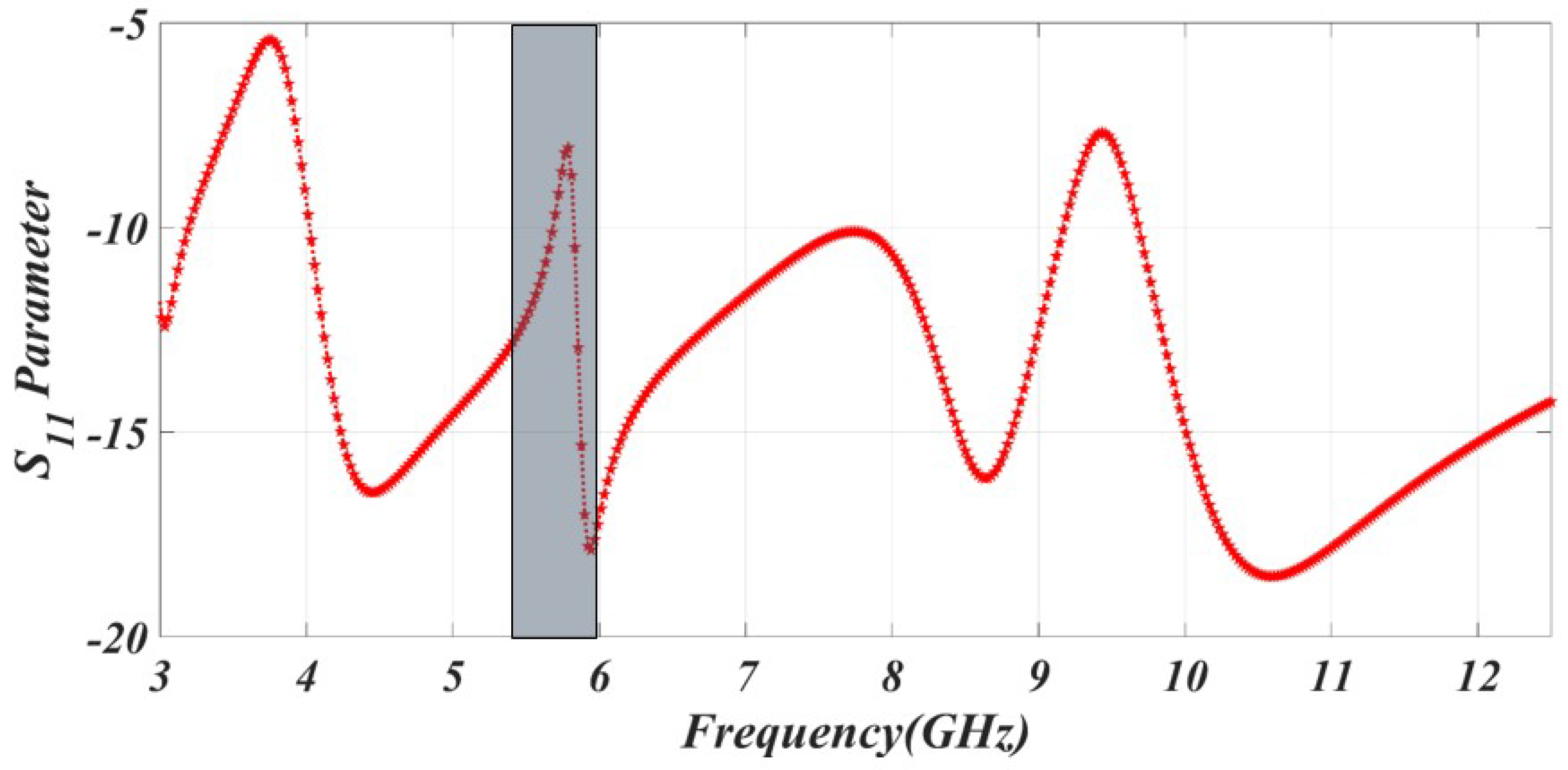


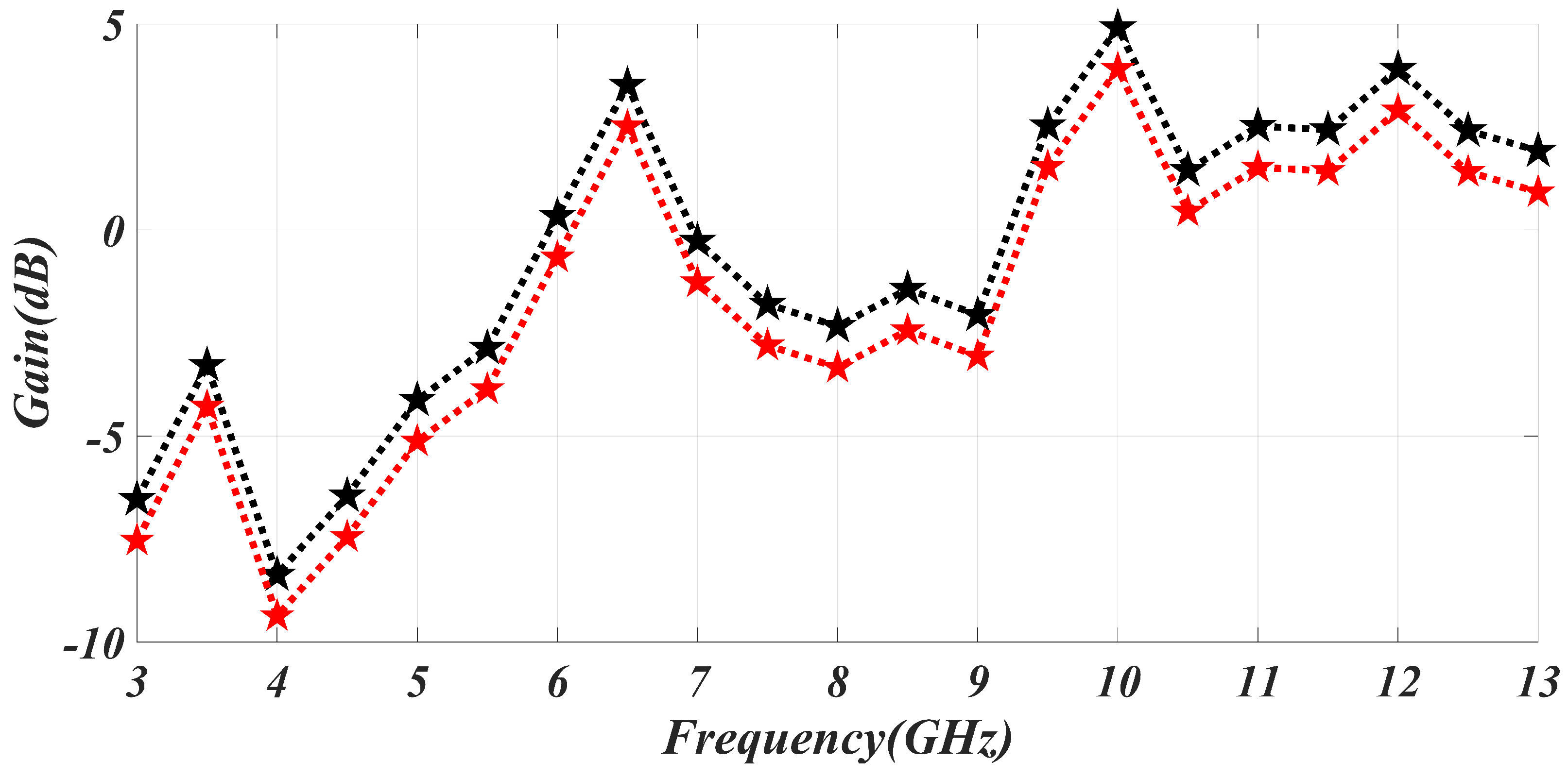

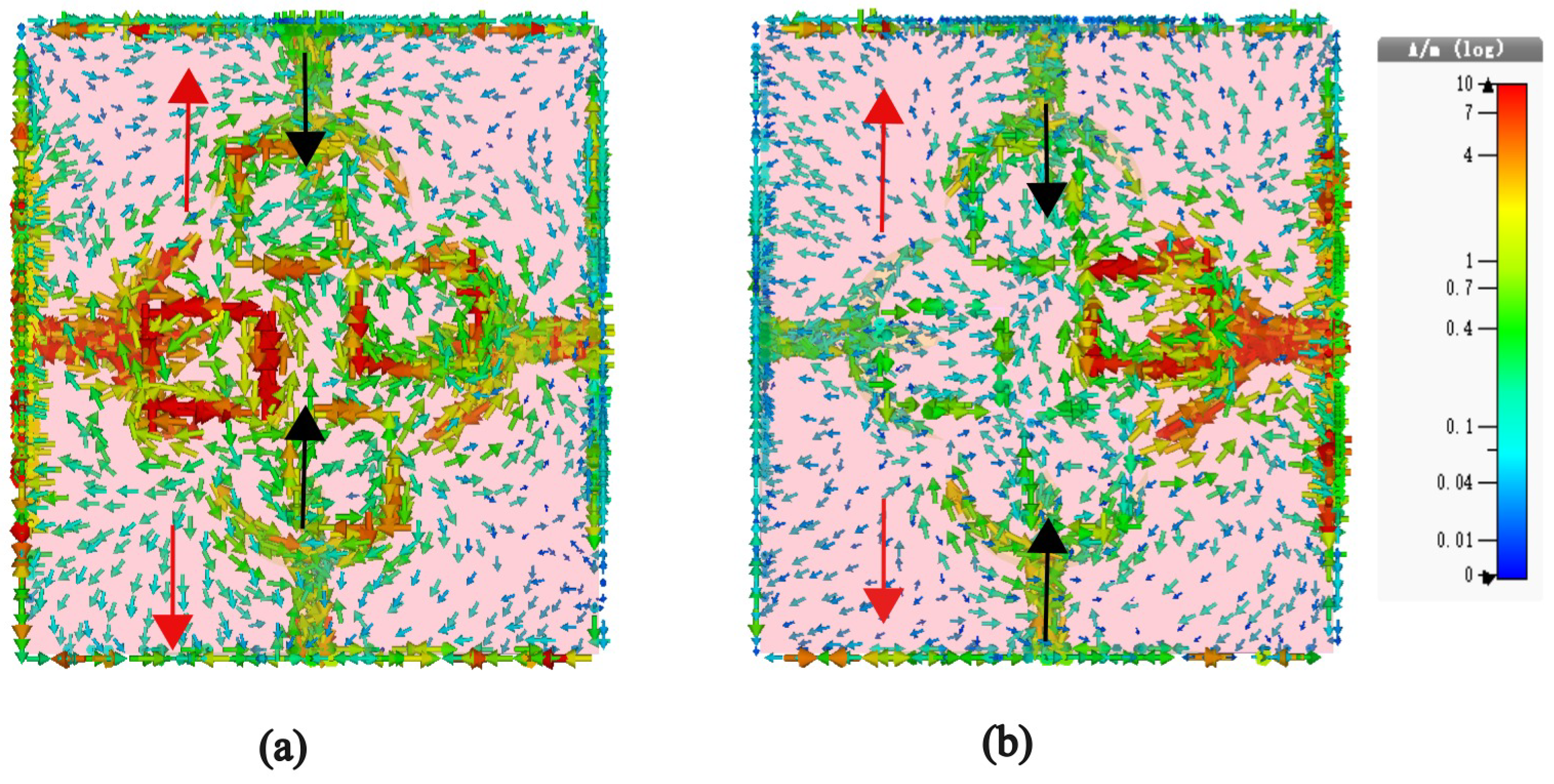
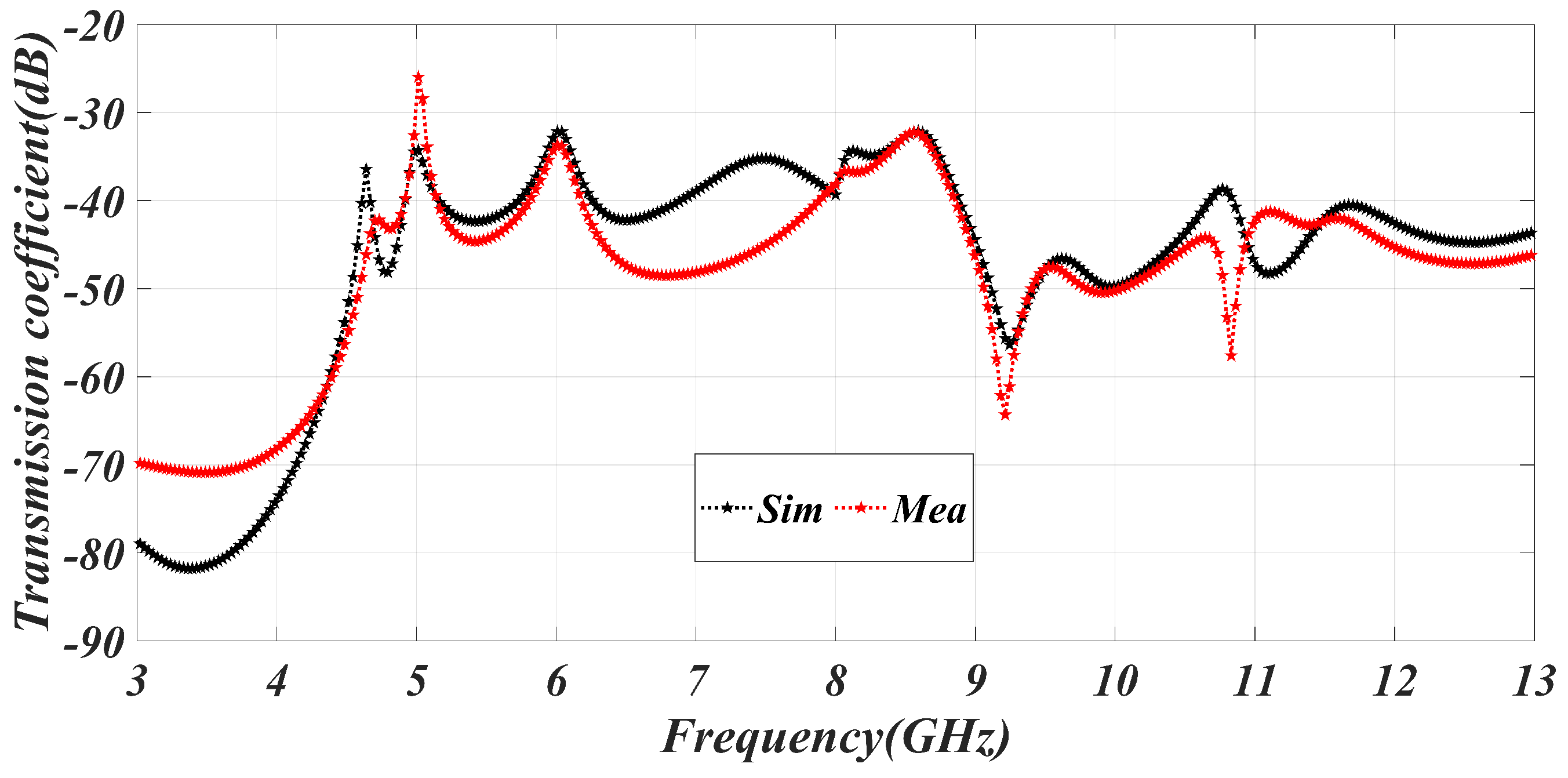
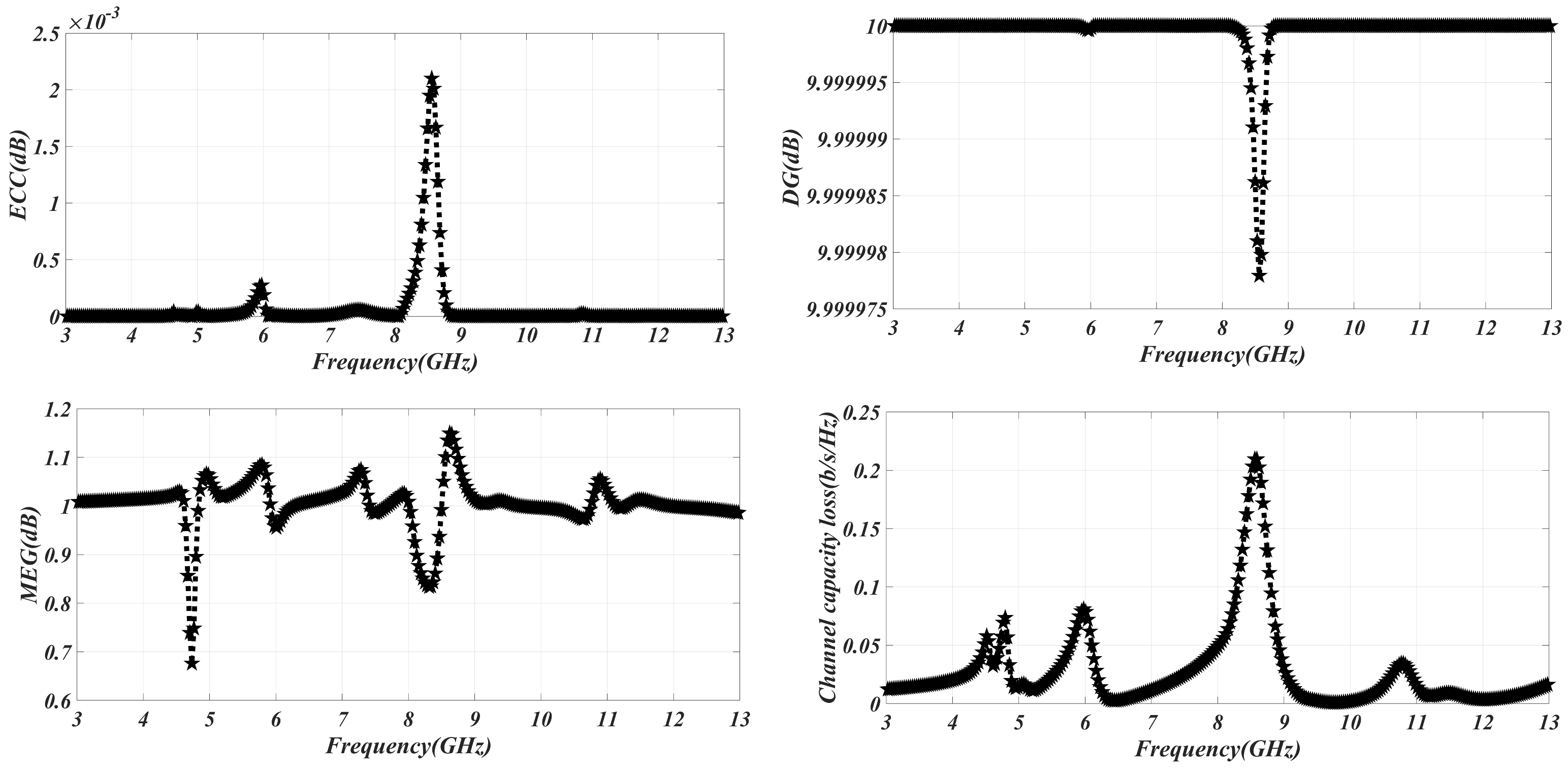
| Antenna | Technique for Notches | Notched Band | No. of Notches | Bnadwidth |
|---|---|---|---|---|
| MIMO or Diversity antenna [21] | L-shaped stub in the ground plane | C-band | 1 | 3.5–4.7 GHz |
| Slot antenna [22] | Rectangular slits | WiMax,WLAN | 2 | 3.3–3.7 GHz, 5.1–5.9 GHz |
| Slot antenna [23] | Two slots on the patch embedding PIN diodes along this slots | Wimax, WLAN | 2 | 3.1–3.8 GHz, 5.4–6.1 GHz |
| Slot antenna [24] | Two Split-Ring Resonators (SRR) | WLAN | 1 | 5.5 GHz |
| Monopole antenna [25] | W-shaped conductor and T-shaped slot on substrate | Wimax, C-band, WLAN | 3 | 3.5–5.5 GHz, 5.2–5.8 GHz |
| Printed monopole antenna [26] | Three open-ended quarter-wavelength slots | WiMax,WLAN, X-band | 3 | 3.3–3.7 GHz, 5.1–5.8 GHz, 7.2 GHz |
| Switched antenna [27] | Switches | WLAN | 1 | 5.1–5.9 GHz |
| Slot antenna [28] | Inverted V-shaped slot | WLAN | 1 | 5–6 GHz |
| Slot antenna [29] | Embedding two stubs | WiMax, WLAN | 2 | 3.5 GHz, 5.8 GHz |
| Slot antenna [33] | Parasitic strip and U-slot | WLAN and satellite | 3 | 5.1 GHz, 5.5 GHz, and 8.2 GHz |
| Circular slot antenna [34] | L and U slot | Wimax, WLAN, and satellite | 3 | 3.2 GHz, 5.2 GHz, and 8.9 GHz |
| Monopole antenna [proposed work] | Two Complementary Split-Ring Resonators (CSRR) at the patch and ground | C-band, WLAN, satellite network | 3 | 4.1–4.3 GHz, 5.2–5.8 GHz, 7.8 GHz |
| Reference | Dimension (mm) Material | Isolation Minimizes (dB) | Technique Employed | Application/Ports |
|---|---|---|---|---|
| [35] | 56 × 68 × 0.2 FR-4 | >−15 at 3.89–17.09 GHz | Plus-shaped slotted | UWB, X, and Ku/4 |
| [36] | 40 × 40 × 1.6 FR-4 | >−20 at 3.1–11 GHz | Decoupling structure | UWB/4 |
| [37] | 45 × 25 × 1.6 FR-4 | >−22 at 3.1–12 GHz | SA asymmetrical placements | UWB/4 |
| [38] | 40 × 53 RT-D5880 | >−30 at 5.45 GHz | m-IFSD | -/2 |
| [39] | 130 × 90 RT Duroid | >8.6 at 1,6 GHz | Common radiator | 5G, WiFi/4 |
| [40] | 120 × 60 × 1.5 RO4350 | ⩾−12 dB at 1.77–2.51 GHz ⩾−25 dB at 0.75–7.6 GHz | Varactor-diode-based switching techniques | UWB Cognitive Radio (CR)/five ports |
| [41] | 90 × 45 × 1.6 FR4 | ⩾−30 dB at 5.5 GHz | Periodic EBG structure-based technique | WLAN/dual ports |
| [42] | 186 × 188 × 1.6 FR-4 | >30 at 2.4 GHz | Diagonal elements | WLAN/4 |
| [43] | 36 × 27 × 1.6 FR-4 | −18 at 7.90–9.59 GHz | MPS radiator | X-band/4 |
| [Proposed work] | 60 × 60 × 1.6 FR-4 | ≥−32 dB at 3–12 GHz | Orthogonal and CSRR | UWB-MIMO/four ports |
Disclaimer/Publisher’s Note: The statements, opinions and data contained in all publications are solely those of the individual author(s) and contributor(s) and not of MDPI and/or the editor(s). MDPI and/or the editor(s) disclaim responsibility for any injury to people or property resulting from any ideas, methods, instructions or products referred to in the content. |
© 2023 by the authors. Licensee MDPI, Basel, Switzerland. This article is an open access article distributed under the terms and conditions of the Creative Commons Attribution (CC BY) license (https://creativecommons.org/licenses/by/4.0/).
Share and Cite
Basir, S.; Qureshi, U.U.R.; Subhan, F.; Khan, M.A.; Mohsan, S.A.H.; Ghadi, Y.Y.; Ouahada, K.; Hamam, H.; Noor, F. A Novel Monopole Ultra-Wide-Band Multiple-Input Multiple-Output Antenna with Triple-Notched Characteristics for Enhanced Wireless Communication and Portable Systems. Sensors 2023, 23, 6985. https://doi.org/10.3390/s23156985
Basir S, Qureshi UUR, Subhan F, Khan MA, Mohsan SAH, Ghadi YY, Ouahada K, Hamam H, Noor F. A Novel Monopole Ultra-Wide-Band Multiple-Input Multiple-Output Antenna with Triple-Notched Characteristics for Enhanced Wireless Communication and Portable Systems. Sensors. 2023; 23(15):6985. https://doi.org/10.3390/s23156985
Chicago/Turabian StyleBasir, Shahid, Ubaid Ur Rahman Qureshi, Fazal Subhan, Muhammad Asghar Khan, Syed Agha Hassnain Mohsan, Yazeed Yasin Ghadi, Khmaies Ouahada, Habib Hamam, and Fazal Noor. 2023. "A Novel Monopole Ultra-Wide-Band Multiple-Input Multiple-Output Antenna with Triple-Notched Characteristics for Enhanced Wireless Communication and Portable Systems" Sensors 23, no. 15: 6985. https://doi.org/10.3390/s23156985
APA StyleBasir, S., Qureshi, U. U. R., Subhan, F., Khan, M. A., Mohsan, S. A. H., Ghadi, Y. Y., Ouahada, K., Hamam, H., & Noor, F. (2023). A Novel Monopole Ultra-Wide-Band Multiple-Input Multiple-Output Antenna with Triple-Notched Characteristics for Enhanced Wireless Communication and Portable Systems. Sensors, 23(15), 6985. https://doi.org/10.3390/s23156985










